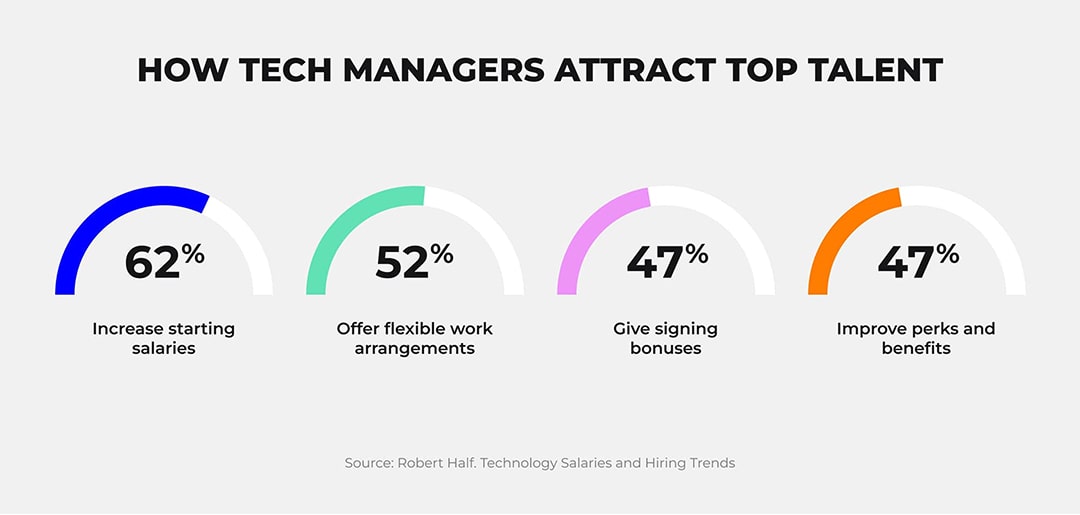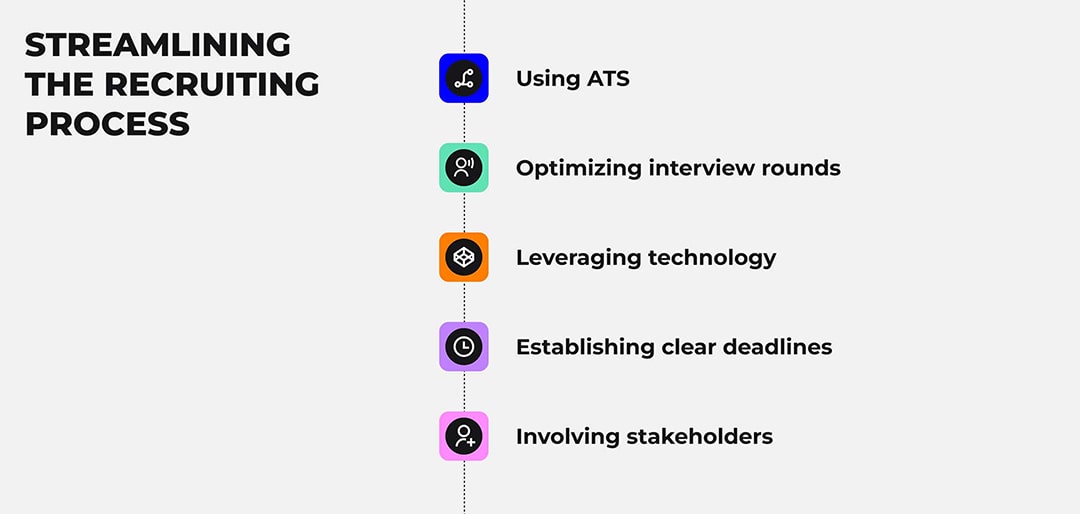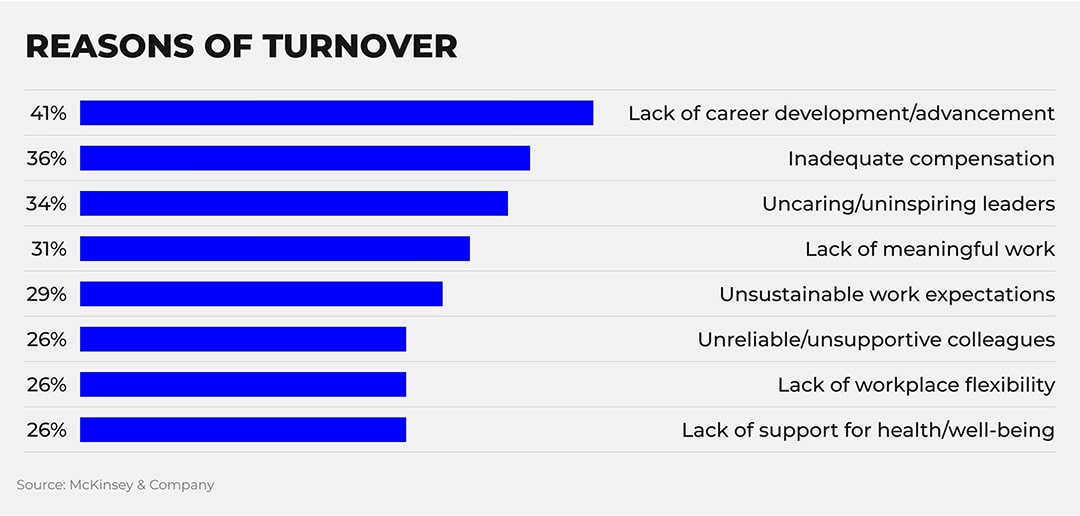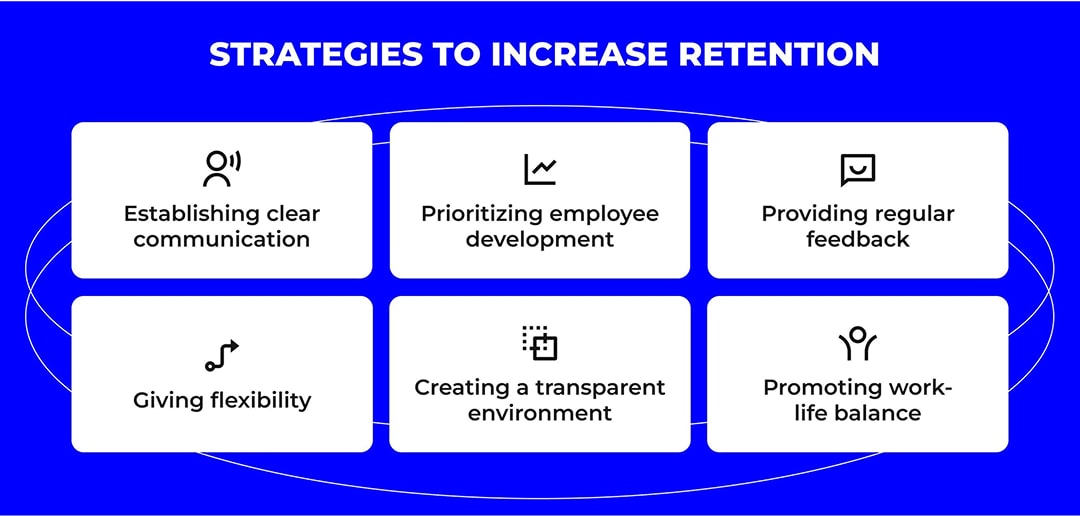The competition in the tech industry doesn't decrease, and many companies still struggle to hire remote employees in short timeframes. In search of filling the gaps in the team and keeping operations ongoing, many businesses try to balance between finding workable solutions for quick hiring and retaining the existing talents for longer assignments.
In this article, we overview the practical steps that can help you accelerate your process to hire a remote employee and develop long-term strategies for specialists' longer retention.

How to Hire Remote Employees Faster: Key Strategies
While some see tech hiring slowing down, the demand for tech specialists remains strong. This extends the time to hire remote talents, even when you hire remotely from different parts of the world. In such a situation, it’s critical to implement techniques that will allow for a quicker process.
Recruit Remote Workers with a Streamlined Application Process
A key step in hiring a remote employee is improving your application process. Speeding up recruiting remote workers keeps you competitive, especially with the increasing demand for specialized remote talent.
Simplified applications
Optimizing the application process helps in hiring remote employees faster. Many give up already on the first application steps if they see that the requirements are too long. You can minimize the number of steps and questions required for candidates to apply by addressing to fast hiring services. This ensures that the process is frictionless and attracts more applicants. For example, instead of asking for detailed cover letters, allow candidates to submit a LinkedIn profile or a resume only. This reduces barriers for candidates, especially those applying to multiple roles at once.
Today, almost all companies implement Applicant Tracking Systems (ATS) for screening candidates CVs. You can set up the needed criteria, which will allow the tool to find the matching applicants faster. An ATS also automates communication, sending updates to candidates, and scheduling interviews, which reduces the time HR spends on administrative tasks. By eliminating manual steps, hiring remote workers becomes more efficient.
Mobile-friendly applications
With younger generations using mobiles more frequently than PCs, jobseekers often browse job boards and submit applications on their smartphones. Having an application tool tailored to mobile users can widen the pool of candidates. This allows candidates to apply from anywhere, increasing the likelihood of attracting qualified applicants quickly.
Efficient Interviewing Techniques
Well-structured interviewing is critical to hiring a remote team efficiently. Such strategies will streamline the hiring process without compromising its quality.
Video interviews
When you hire remote employees, you benefit from a much bigger talent pool. But this also leads to organizing video interviews, which saves both time and resources. In comparison to setting up in-person interviews, you can use tools like Zoom or Microsoft Teams to evaluate candidates from anywhere in the world. A manager who hires remote workers and uses video interviews speeds up the hiring process by eliminating scheduling conflicts and travel times.
Well-structured interviews
Structured interviews bring a certain level of fairness and objectivity in evaluating the candidates. How to hire remote employees using a common approach? Try to create a structure or a certain set of questions that you would ask all candidates (e.g. STAR method). This allows for easier comparison and faster decision-making. Such approach allows reducing biases and assessing candidates in the same manner and against the same criteria. We also suggest limiting a number of interview rounds to 3 to reduce the recruiting process in time. If you struggle with the recruitment process or seek help of specialists, our IT recruitment services can be of great help.
Asynchronous interviews
One of the possible time-saving techniques is asynchronous interviewing. Incorporating asynchronous interviewing, where candidates record responses to pre-set questions, allows hiring remote foreign employees across different time zones without live coordination.
If you're looking for assistance to make your interviews relevant and up to the point, our team of professionals is there to help you.
Order fast hiring
Rapid Decision-Making for Hiring a Remote Employee
Clearly defining deadlines and inviting hiring manager to later interviews stages early enough ensures faster decision-making in the hiring remote employees process. Automating pre-employment check, such as background verification, can prevent delays, helping you onboard new hires more quickly.
Early involvement of key stakeholders
One of the common bottlenecks when you hire remote workers is waiting for input from multiple stakeholders. To accelerate decision-making, don't wait for the final feedback and involve managers in the process earlier. This ensures that everyone is aligned on what the company is looking for and that feedback can be provided promptly.
Set clear deadlines for decisions
Establish firm deadlines for each stage of the process, from screening to final decision-making. This prevents delays and speeds up hiring.
Efficient reference and background checks
Reference and background checks are often one of the most important steps in the hiring process and can be a source of delay. Use online tools that expedite these verifications, allowing you to confirm a candidate’s credentials quickly. Automating this process ensures that you can make decisions and hire virtual employees without unnecessary delays.
Leverage Technology to Accelerate Hiring
In the times of artificial intelligence (AI) conquering all our spheres, we cannot help but use it in the hiring process. With AI-powered screening tools, detect fake candidates and filter top prospects faster, save time, and make the overall hiring more efficient.
AI-powered screening tools
AI can be a powerful tool in speeding up remote hiring. AI-powered screening tools are helpful when you hire employees online, flagging the best candidates based on qualifications and job fit. These tools can quickly filter out candidates who don’t meet key criteria, allowing you to focus on top prospects only.
Remote collaboration tools
Effective communication is a must, especially for remote candidates. Collaboration tools like Slack or Trello ensure that stakeholders stay informed, allowing for rapid decisions when you recruit remote workers. These tools are helpful for tracking progress, staying on track, or providing feedback.
Virtual onboarding
For a new hired, onboarding helps to get quickly on track, integrating into the team and the project. By using various platforms and training materials, you help a new specialist become productive in shorter timelines. As a result, new employees feel support and integrate more quickly into the team.

From Hiring Remote Workers to Retaining Them
Hiring employees quickly is just the beginning. While hiring a remote employee efficiently is important, retaining them long-term is equally crucial. To hire a remote employee for long-term success and further retention requires thoughtful strategies, such as fostering a positive company culture, career development opportunities, and employee well-being. Once you've planned your IT staff augmentation and hired talents, the next step is keeping them engaged and committed. Let's explore key retention strategies that will help your company maintain a stable and motivated remote workforce.
Need to create new strategies from scratch? Our team is experienced in both hiring and retention.
Find top talents with us
Best Practices for Long Retaining
Fostering a Strong Remote Company Culture
According to Work Institute, the most frequent cause of employees' turnover is not compensation, as many would think from the first sight. The top considerations include career development, job satisfaction, health & family, and work-life balance. These are all the aspects that companies have direct influence on and can approve. They have a direct impact on a specialist's further retention.
The following practices can increase the overall trust and satisfaction of employees, consequently leading to higher retention rates.

Clear communication channels
Communication is especially crucial in a remote working environment. To retain employees, it's essential to establish clear communication channels, such as scheduled check-ins, video calls, and chat platforms like Slack. These channels ensure that remote workers feel connected and informed, which reduces feelings of isolation and disengagement.
Inclusive and engaging virtual events
A strong company culture is built on relationships, and fostering these relationships in a remote environment requires intentional effort. Organizing virtual team-building activities, social events, and informal hangouts can help remote employees feel like part of a cohesive team. Some of the examples that we see have a positive impact are organizing quiz competitions or monthly book/movie clubs to share opinions, ideas, and have an engaging time with team members.
Prioritizing Employee Development
According to LinkedIn, 94% of employees stay in the company longer if the latter invests in their development. There are a couple of activities that you can implement to keep the ongoing track of a specialist's satisfaction in this area.
Career growth opportunities
Remote employees, like their in-office counterparts, seek opportunities for professional growth. Offer development plans, different training materials, or mentorship programs. Specialists who have the possibility to grow together with the company are more likely to stay longer and engaged.
Regular feedback and performance reviews
With regular feedback, specialists feel heard and valued. Digital tools can be used to track progress and provide continuous feedback. This approach keeps employees engaged and ensures they follow the same direction as the company does. An example can be organizing regular one-to-one meetings where specialists can share their expectations and needs.
Offering Competitive Benefits and Flexibility
Being competitive doesn't only mean offering a competitive monetary compensation. Benefits can also include flexible working hours, development opportunities, or interesting projects. Defining what your company can offer to top talents is what will differentiate you from the competitors.
Comprehensive remote benefits
Remote employees have unique needs, and you should find a balance between your company's possibilities and specialists' needs. Some examples can include wellness programs, educational courses, or mental health support. Offering flexible hours also helps remote workers balance personal and professional responsibilities, making them more likely to stay.
Flexibility in work schedules
Flexibility is one of the current candidates' requirements. Offering remote employees the ability to set their schedules and work from anywhere helps them manage time zones, family obligations, and personal commitments. Flexibility contributes to job satisfaction and long-term retention. Define with new hires information on flexibility and the ways of working at the beginning of your cooperation. This will eliminate unrealistic expectations.
Building a Transparent and Trust-Based Environment
According to the report of Work Institute, Management is one of the top 5 reasons why specialists decide to change their jobs. This area incorporates both behavior, support communication, and knowledge and skills development. That's why it is important to create a transparent environment to build a trustful and open communication between specialists and management.
Encourage autonomy
Autonomy is a key factor in job satisfaction. Empowering remote employees to manage their tasks with minimal supervision fosters trust and increases engagement. When you entrust employees to do their work, they feel safe and loyal to the company.
Transparency in decision-making
Being transparent about company goals, decisions, and challenges helps professionals feel more connected to the bigger picture. With that in mind, they feel more certain and secure.
Supporting Remote Employee Well-Being

Indeed's recent study shows that among the top reasons why employees quit their job is better work-life balance (26%) that hits the ranks. This reason even precedes better working environment, compensation, or growth opportunities. With that in mind, managers have space to improve the overall company's culture and environment to eliminate or at least decrease this reason for tenure lifecycle.
Mental health support
Working distantly can sometimes cause challenges with time management and communication, consequently leading to burnouts and loneliness. Think of offering support in the form of mental health programs or regular wellness check-ins. This will give a needed support to specialists.
Encourage work-life balance
Promoting work-life balance is crucial to preventing burnout. Setting clear boundaries for work hours, encouraging employees to take breaks, and offering paid time off all contribute to a healthier and more sustainable work environment for remote workers.
Final Thoughts
Building a successful remote workforce requires both efficient hiring and strong retention. Streamlining hiring with technology helps fill roles quickly, while fostering a positive culture, offering career growth, and prioritizing employee well-being keeps remote teams engaged. These strategies ensure a remote team that is not only fast to assemble, but also productive and loyal over time.
Considering all these points to reduce employee turnover can be tiring and overwhelming. Entrust these activities to professionals to get the desired results.
Leave us a note
FAQ
How can you address potential challenges such as isolation and burnout among remote employees?
To eliminate the cases of burnout, it's important to identify employees' needs early enough. For that, you would need to foster open communication and safe environment, where specialists can openly talk about their workload and their projects. Implementing work-life balance strategies will put an end to burnouts.
How can you effectively source remote talent?
The most efficient way is to use referral programs, global job platforms, and professional networking sites. Implement AI-tools to streamline the process, or partner with recruiting agencies that specialize in the field.
How can you assess a candidate's work-from-home setup and productivity habits?
Start with asking candidates about their remote environment and set-up. Assess their availability and connectivity with video interviews. Giving a remote task can help you assess their time management, productivity, and their availability to work independently.
Ann Kuss is the CEO at Outstaff Your Team. After 11 years of expertise in building remote tech teams for startup unicorns and global tech brands, Ann decided to lead a new venture aiming to reinvent the way international tech teams scale. Throughout her career, Ann hired specialists for countless tech positions from more than 17 countries on all major continents. Ann graduated from Kyiv-Mohyla business school, is an MIM Kyiv alumna, and regularly takes part in mentorship programs for junior tech talents. Ann actively promotes knowledge sharing and curates Outstaff Your Team blog strategy, preferring topics that solve practical needs of IT leaders. She believes that structuring business flows (including hiring) is a well-planned journey with predictable and successful outcome.




